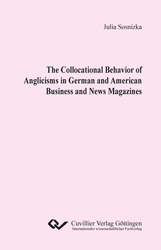| Areas | |
|---|---|
| Serie de libros (96) |
1378
|
| Nachhaltigkeit |
3
|
| Gesundheitswesen |
1
|
| Letra |
2364
|
| Medienwissenschaften | 16 |
| Teología | 57 |
| Filosofía | 102 |
| Derecho | 422 |
| Economía | 850 |
| Ciencias sociales | 416 |
| Ciencias del deporte | 48 |
| Psicología | 233 |
| Educación | 190 |
| Historia | 182 |
| Arte | 111 |
| Ciencias culturales | 166 |
| Literatur | 116 |
| Lingüística | 88 |
| Ciencias Naturales |
5406
|
| Ciencias Ingeniería |
1793
|
| General |
98
|
|
Leitlinien Unfallchirurgie
5. Auflage bestellen |
|
Erweiterte Suche
The Collocational Behavior of Anglicisms in German and American Business and News Magazines (Tienda española)
Julia Sosnizka (Autor)Previo
Indice, PDF (34 KB)
Lectura de prueba, PDF (140 KB)
In her dissertation, Julia Sosnizka deals with the question whether and to what extent the collocational behavior of (written) Anglicisms in German resembles the collocational behavior of these word-forms in the source language (American) English. The study is empirically based on the 2008 volumes of the business magazines BusinessWeek and WirtschaftsWoche and the news magazines Newsweek and Der Spiegel. This selection allows also for statements about differences between the thematically specialized corpora and those that are closer to general language use. In total, the research corpora comprise over nine million words. The study is inspired by the observation that Anglicisms are not only transferred as isolated word-forms from English to German, but that instead they may be borrowed along with their collocates. The author provides a broad overview on collocations, which is treated very differently in the literature. In addition to the corpus linguistic approach, she also discusses psycholinguistic and semantic models of collocations. The understanding of collocations for the present study is based on the statistically significant co-occurrence of lexical word-forms. The dissertation may be seen as a contribution to contrastive corpus linguistics, collocation and genre research.
In ihrer Dissertation beschäftigt sich Julia Sosnizka mit der Frage, ob und inwieweit das Kollokationsverhalten von (geschriebenen) Anglizismen im Deutschen dem Kollokationsverhalten dieser Wortformen in der Ursprungssprache (amerikanisches) Englisch entspricht. Als empirische Grundlage dienen die Jahrgänge 2008 der Nachrichtenmagazine Newsweek und Der Spiegel sowie der Wirtschaftsmagazine BusinessWeek und WirtschaftsWoche mit insgesamt über neun Millionen Wörtern. Diese Auswahl ermöglicht gleichzeitig Aussagen über Unterschiede zwischen thematisch spezialisierten Korpora und solchen, die näher an der Allgemeinsprache sind. Die Arbeit ist inspiriert durch die Beobachtung, dass nicht nur Wortformen aus dem Englischen ins Deutsche übernommen werden, sondern auch deren Kollokate. Die Autorin gibt in der Arbeit einen umfassenden Überblick zum Thema Kollokationen, welches in der Literatur sehr unterschiedlich behandelt wird. Neben dem korpuslinguistischen Ansatz erörtert sie auch psycholinguistische und semantische Erklärungsmodelle für Kollokationen. Das Verständnis von Kollokationen für die vorliegende Arbeit beruht auf statistisch signifikanter Kookkurrenz von lexikalischen Wortformen. Die Dissertation ist somit als ein Beitrag zur kontrastiven Korpuslinguistik, Kollokations- und Genreforschung zu sehen.
| ISBN-13 (Impresion) | 9783954047123 |
| ISBN-13 (E-Book) | 9783736947122 |
| Formato | A5 |
| Idioma | Alemán |
| Numero de paginas | 268 |
| Laminacion de la cubierta | Brillante |
| Edicion | 1 Aufl. |
| Lugar de publicacion | Göttingen |
| Lugar de la disertacion | Bonn |
| Fecha de publicacion | 27.05.2014 |
| Clasificacion simple | Tesis doctoral |
| Area |
Lingüística
|
| Palabras claves | Kollokationen, Anglizismen, Anglizismenforschung, Kollokationsverhalten, Kollokationsforschung, kontrastive Korpuslinguistik, Collocations, Anglicisms, collocational behavior, contrastive corpus linguistics |








